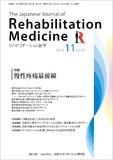Japanese
English
- 販売していません
- Abstract 文献概要
- 1ページ目 Look Inside
- 参考文献 Reference
はじめに
心筋症診療ガイドライン1)では,肥大型心筋症(hypertrophic cardiomyopathy:HCM)は「①左室ないしは右室心筋の肥大,②心肥大に基づく左室拡張能低下を特徴とする疾患群」とされる.臨床的にはHCMは,2次性心筋症を除外のうえ,心エコー検査や心臓magnetic resonance imaging(MRI)で,15 mm以上の最大左室壁厚(家族歴がある場合は13 mm以上)で定義される.心筋の収縮単位であるサルコメアなど心筋構成蛋白(β-ミオシン重鎖,トロポニンTまたはI,ミオシン結合蛋白Cなど)をコードする遺伝子異常が主な病因2, 3)であるが,家族性例の半数以上はこれらの遺伝子異常に起因し,孤発例の一部も同様である4).大部分の患者が無症状か,わずかな症状を示すだけであるが,症状を有する場合には不整脈に伴う動悸やめまい,運動時の呼吸困難・胸の圧迫感などがあり,重篤な場合は失神や突然死を呈する.
2002年にわが国で行われた大規模な疫学調査では,HCMの年間死亡率は2.8%であり,死因としては不整脈による突然死が31.9%,心不全が21.3%であった5).治療法の進歩も相まって死亡率の改善が報告6-8)されているが,若年者(25歳未満)では突然死が多いとされている1).そのため,心停止後の心肺蘇生法の早期開始や突然死予防のための植込み型除細動器(implantable cardioverter defibrillator:ICD)の適応が重要視されている.
今回報告する症例は,家族歴を有する若年HCMである.他院循環器内科に通院中で,分類は非閉塞性であり,イベント発生時まで不整脈などの突然死主要リスク因子1)を認めなかった.今回,屋外で心肺停止の状態で発見され,発症時心電図では心室細動があり除細動で心拍再開となったが,発症から発見されるまでの時間は不明であった.一定時間以上の心停止を認め,蘇生後脳症の診断となった.蘇生後脳症は高次脳機能障害を呈することがあり,社会復帰に向けて支援が必要である9).本邦における高次脳機能障害症例の相談支援は,高次脳機能障害支援モデル事業10)として2001年より開始された.それに伴い,高次脳機能障害と循環器疾患の併存症例の支援施設は近年増加しており,当院での取り組みは支援モデルの1つである.当院は,循環器内科医が常勤し,関連急性期病院とは,脳血管や運動器リハビリテーションの連携だけでなく,シームレスな心臓リハビリテーション(cardiac rehabilitation:CR)連携も実施している.CR連携により,当院のCRプログラムは,運動療法に加えて,蘇生後脳症の高次脳機能障害の支援もシームレスに行えている11).
本症例は保育科大学生であり,復学に必要とされた要件を満たすためにシームレスな連携と長期的な支援を行った.まず,関連急性期病院での原疾患への治療から,当院での回復期入院リハビリテーション,そして,外来でのCRへの引き継ぎがシームレスに行われた.さらに,蘇生後脳症の高次脳機能障害への支援として作業療法(occupational therapy:OT)による長期的な高次脳機能への訓練を行った.高次脳機能障害が残存した中での至適運動強度と生活活動強度の指導は難渋したが,日常生活において活動強度を遵守することが可能となり,復学に至った.これらの経過と治療について報告する.なお,本報告に際し,症例に十分な説明を行い書面にて同意を得た.
Abstract We report the case of a 20-year-old woman with hypertrophic cardiomyopathy and severe brain dysfunction caused by post-resuscitation encephalopathy. Transferred to our hospital's convalescent rehabilitation ward, she aimed to regain independence in daily living and return to college. Upon admission, she was diagnosed with moderate attention impairment and intellectual disability. She underwent a 4-month intensive inpatient rehabilitation program, including occupational therapy (OT). Despite modest improvements in day-to-day activities and brain function by discharge, these were insufficient for her to resume university childcare classes. Further improvement in behavioral control, physical activity management, and exercise tolerance was necessary post-discharge.
OT is pivotal in supporting patient self-management of day-to-day activities, is included within the cardiac rehabilitation (CR) program covered by health insurance. Thus, we introduced her to the CR program for aerobic exercise training and OT. Counseling for physical activity based on the aerobic threshold was performed at each visit, using a chart to record daily activities and heart rate to prevent overactivity, which could lead to fatal arrhythmia.
Eventually, she resumed her classes and engaged in childcare training. For patients with brain and heart conditions, a combination of rehabilitation in the convalescent ward and outpatient CR seems to be beneficial for secondary prevention and long-term self-management.

Copyright © 2024, The Japanese Association of Rehabilitation Medicine. All rights reserved.


